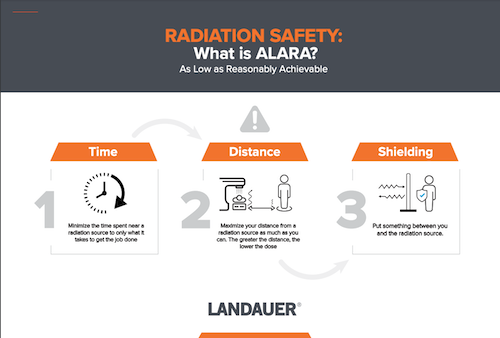
Why are X-Ray Badges Required? The Reasons Why Dosimetry is Necessary
Many practice managers who are new to occupational radiation exposure find themselves wondering, “Why are X-ray badges required?”
 X-ray badges are required for radiation safety and compliance.
X-ray badges are required for radiation safety and compliance.
Using radiation to assist in making medical diagnoses and treatments has become a deep and essential part of patient care. Thousands of times a day, radiation is used by multiple medical disciplines to provide doctors and staff with critical data to help treat their patients.
For those who work with radiation daily, there is standard PPE (e.g., lead aprons, thyroid shields, syringe shields) that helps protect them from too much radiation exposure. But there is an additional critical, often mandatory, piece of equipment – the dosimeter (aka X-ray badge) - that measures a worker’s radiation exposure and provides reports as required by regulations.
Why Are X-ray Badges Not Only Required, but Necessary?
X-ray badges are necessary for radiation safety and compliance; however, the necessity of X-ray badges goes beyond that. Are dosimeters mandatory? The short answer is yes, but the need for these badges is more than checking a requirement off a list. Below are five key reasons X-ray badges are essential:
- They help you maintain compliance with regulatory requirements
- They help you follow your Radiation Protection Program (RPP) and ALARA guidelines
- Radiation is undetectable to human senses
- Radiation scatters, making shielding more difficult
- In case questions around exposure arise, they can provide a measure of liability protection
These devices are vital to creating a safe working environment and atmosphere. Since X-ray badges use dosimetry to measure received doses of ionizing radiation, these devices are the key to tracking radiation exposure risks. The dosimeters provide the necessary data to form and manage successful radiation protection plans.
Who Should Wear X-ray Badges?
In general, dosimeters are required for anyone who could receive up to 10% of the annual radiation exposure limit or as specified by the conditions for monitoring personnel within your state regulations. Radiation badges are required to track radiation exposure if anyone works with or around devices or materials that emit X-ray radiation and will meet the regulatory threshold that requires monitoring.
Specifically, workers who operate X-ray machines often need to wear badges. This involves employees who work with machines including:
- Fluoroscopic X-ray units
- Therapeutic X-ray units
- X-ray diffraction equipment
- X-ray fluorescence equipment
- C-arm X-ray machines
- Cabinet X-ray systems
Badges are also required for exposure monitoring if people work with X-ray emitters such as employees who administer radiopharmaceuticals to patients or those working in research labs. They also should be worn by any Declared Pregnant Worker who works near X-ray emitters in a laboratory or around X-ray emitting equipment.
When to Wear X-ray Badges?
X-ray badges need to be worn anytime workers are in environments where they could be facing radiation exposure - whether it be from equipment or X-ray-emitting radioactive sources. Types of X-ray badges can vary from whole-body dosimeters to thermoluminescent dosimeters and others.
Five Reasons Why X-ray Badges are Required
#1 X-ray Badges are Required for Compliance
The NRC (Nuclear Regulatory Commission) and state agencies have regulations around most industries that use ionizing radiation. There is a wide variety of industries, from dental offices to cath labs, nuclear power plants to road construction. There is also a wide variety of equipment in use – the regulations do not only apply to X-ray devices, but also include nuclear devices, fluoroscopy units, and CT scanners. To comply with the NRC and state agencies, you must follow their exposure limits, the types of equipment covered by the regulations, the type(s) of dosimeters that must be used, who is required to wear a dosimeter and when, the need for an RPP, inspection requirements, and much more.
The regulations will vary from state to state, and many states, called “agreement states,” have regulations that go beyond those set down by the NRC. If you’re not sure about the requirements for your program, please review your state and federal guidelines, or contact LANDAUER Medical Physics for a consultation.
#2 Dosimeters Help You Meet RPP and ALARA Limits
The vast majority of practices will be required to have a Radiation Protection Program in place. This program will outline the policies and procedures your team follows to maintain compliance in all areas of radiation safety. Some areas it should cover include:
- Personnel dosimetry
- Shielding design
- Required supplies
- Equipment installation and registration
- Fetal dose policy
- Radiation safety education
- Equipment testing and maintenance
- State-specific laws
In addition, national, state, and local agencies closely monitor radiation exposure to ensure that ALARA (As Low As Reasonably Achievable) principles are practiced. Your organization’s ALARA program follows various processes to reduce the length of time a person is exposed, their distance from the source, and the shielding that is used.
#3 Dosimeters Measure Invisible Radiation
Unlike many other hazards, radiation is one that cannot be detected by our senses. Special devices are required to reveal the presence of radiation, and it’s vital to know how much is being absorbed by your staff.
It is easy to forget to put on your badge, and some practices that are not required to use dosimeters elect to forgo their use. However, this is not advised, regardless of what your regulations say!
Without a dosimeter, the radiation dose technologists receive is completely unknown. Even if you’ve shown minimal exposure over the course of a year or more, in no way does that allow you to definitely answer the question of how much exposure did your staff actually receive. And that is a very important question you may need to answer someday!
#4 Radiation Scatters
Not only is radiation undetectable to the senses, but it also scatters around the room in unpredictable ways. Once it hits a surface like the patient or table, it bounces around and may penetrate many types of materials like drywall, brick, glass, skin, and even lead. That means, even if you’re behind a wall, equipment, or someone wearing shielding, it’s likely that you are still receiving some level of radiation dose. If a job requires working with radiation more frequently than anticipated, exposure could be higher than assumed or expected. Every time there a procedure is done, there is radiation. So the more procedures that are done, the higher the dose received. A dosimeter will measure that exposure dosage no matter where a person is standing or what procedure is taking place.

#5 Reduce Potential Financial Repercussions
Organizations must be aware of the potential financial impact of failing to have technicians wear dosimeters and adhere to radiation program guidelines.
Firstly, if they are required by your regulatory body, not using them (or using them incorrectly) can be very costly. In addition, receiving a citation for being out of compliance could result in negative PR that could affect your reputation and, more importantly, in the loss of patient trust.
Secondly, there is the potential for legal liability. A technologist could claim that a health issue was caused by on-the-job exposure to radiation. If they weren't wearing a dosimeter when this exposure supposedly occurred, there is no way to access data that could defend against that claim. Even if you’ve complied in the past with a temporary requirement to badge your employees, changes to your equipment, procedure load, and employee scheduling can make that data inapplicable to the situation in question.
Are There Legal Reasons for Wearing X-ray Badges?
While X-ray badges, or dosimeters, are first and foremost worn for safety, there are legal reasons for wearing them too. There are numerous rules and regulations that need to be adhered to for compliance. These vary based on the location of the company due to different legal standards across localities.
This data also legally protects workers by helping them track how much radiation exposure they face in their day-to-day jobs. Dosimeters can reveal if they’re facing dangerous levels of radiation exposure, ensuring workplaces take the proper steps to limit further exposure and protect the health of their employees. Oppositely, the data from these badges also helps protect the company from health-based lawsuits.
In Summary: Dosimeters Help Everyone Involved
Whether your biggest concern is employee safety, compliance, or liability issues, dosimeters can help provide peace of mind. Ensure your staff is wearing them properly, your exchanges are happening on time, and you’re prepared for your next inspection or survey!
If you’re in need of dosimeters, Landauer has a long history of providing dosimeters including those ideal for workers facing X-ray exposure. If you’re interested in ordering dosimeters for your organization, reach out to learn more about the dosimetry process and how it can help elevate your radiation protection plan.

